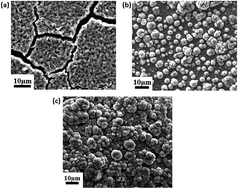Electrochemical behaviour of chromium–graphene composite coating
Abstract
This work illustrates the role of graphene in enhancing the corrosion resistant properties of chromium–graphene composite coating when compared to the corrosion resistant properties of pure chromium coating containing ZnO nanoparticles. Chromium based coatings have been used extensively due to their various useful attributes such as corrosion and wear resistance and enhanced surface finish. In this work, Cr and Cr–graphene composite coatings were electrodeposited over mild steel substrate using Cr(III) plating bath. To deposit the coatings, an electrodeposition method was also adopted due to its attributes such as low cost, less equipment intensive methodology, accuracy of reproduction and suitability for large scale surface modification. Three different coatings were produced: (a) Cr coating containing ZnO nanoparticles (C), (b) Cr coating containing ZnO nanoparticles deposited using formic acid (CF) and (c) Cr coating containing ZnO nanoparticles and graphene deposited using formic acid (CFG). Graphene used in the deposition process was produced from the electrochemical exfoliation of graphite in sodium lauryl sulphate (SLS) electroactive media. ZnO nanoparticles were synthesized using the precipitation method followed by calcination. Microstructural characterization of the coatings revealed that the coating ‘C’ contained large cracks. Addition of formic acid (in the coating CF) noticeably reduced the cracks in the coating which now also contained hillock structures. Addition of graphene (in coating CFG) further enhanced the coating morphology which now contained negligible cracks and increased hillock structures completely covering its surface. Diffraction analysis revealed that the addition of graphene also altered the texture of the chromium coatings. Potentiodynamic polarization and electrochemical impedance spectroscopic analysis revealed that the change in the morphology and microstructure of the deposit due to the addition of graphene substantially enhanced the corrosion resistance of the CFG coating when compared to both C and CF coatings.


 Please wait while we load your content...
Please wait while we load your content...